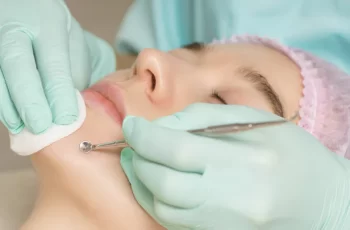
Hello, beauties! Morgan here, the founder of Enlightened Beauty and a holistic esthetician with over a decade of experience and pure-hearted dedication to helping you achieve radiant skin from the inside out.
Today, I want to share some eye-opening insights about a hidden culprit that might be affecting your skin and truly isn’t talked about enough in the skincare community: streptococcus.
Did you know that antibiotics, often prescribed for acne, could be making things worse by increasing your risk of carrying a bacteria known as Group A Streptococcus (GAS)? According to a study by the National Center for Biotechnology Information (NCBI), people with acne treated with antibiotics are three times more likely to harbor this bacteria than those who aren’t on antibiotics or don’t have acne at all.
In addition to this, people who’ve had strep throat or other streptococcal infections in childhood may still be carrying this bacteria in their bodies. Even if you feel fairly healthy, chronic, low-grade streptococcus can hide out in your lymphatic system, silently wreaking havoc on your skin and overall health.
At Enlightened Beauty, we believe in a holistic approach to skincare, understanding that what we eat and how we care for our bodies play crucial roles in our skin health. Let’s dive into how streptococcus can influence acne and how making mindful dietary choices can be a game-changer for your skin.
Now, lets dive in and get you on your path towards clearer, healthier skin by addressing the root causes and nourishing your body with the right foods.
Understanding Streptococcus and Acne
Streptococcus is a type of bacteria that can cause various health issues, including acne, UTIs, pneumonia, SIBO, yeast infections, bacterial vaginosis, migraines, styes, and sinus problems. According to the Centers for Disease Control and Prevention (CDC), streptococcus bacteria are responsible for a range of infections and can also cause inflammatory diseases.
Chronic, low-grade streptococcus can reside in the lymphatic system, contributing to persistent acne. This bacteria can move from the liver to the lymphatic system and even reach the skin, leading to cystic acne. When the immune system is compromised by poor diet, stress, or lack of self-care, managing streptococcus becomes challenging, allowing it to affect the skin more severely.
If you suffered from strep throat or similar illnesses in childhood, you may still be carrying streptococcus bacteria in your body. This hidden presence can increase your odds of developing streptococcus-related acne later in life. Even if you feel generally healthy, chronic streptococcus can lie dormant and resurface when your immune system is weakened, leading to persistent skin issues.
ACNE & ANTIBIOTICS
Antibiotics are commonly prescribed for severe cystic acne due to their initial effectiveness in reducing bacterial load. However, the overuse of antibiotics has led to the emergence of antibiotic-resistant strains of streptococcus, making them less effective over time and often worsening ones battle with acne in the long run. It’s imperative to understand that while antibiotics may offer temporary relief, they do not address the underlying issue of streptococcus-related acne.
Foods to Combat Streptococcus
According to the Medical Medium, a holistic approach to skincare includes nourishing your body with foods that help fight off streptococcus. Incorporating these healing foods into your diet can support your immune system and promote clearer skin:
Garlic: Known for its powerful antibacterial properties, garlic is incredible for killing streptococcus.
Onion: Helps eliminate streptococcus and H. pylori, which often accompanies certain strains of streptococcus.
Leafy Greens: Mâche, spinach, kale, chard, butter leaf lettuce, red leaf lettuce, and green leaf lettuce are excellent for killing streptococcus over time.
Berries: Cherries and all berries contain natural antibacterial properties that help fight streptococcus.
Bananas: Fantastic for combating strep and supporting overall digestive health.
Wild Blueberries: These superfoods break down streptococcus and heal other related issues, including SIBO, UTIs, pneumonia, styes, migraines, bacterial vaginosis, yeast infections, and sinus problems.
Herbs and Spices: Peppermint, oregano, thyme, sage, ginger, turmeric, cayenne pepper, and cinnamon have strong antibacterial properties that help fight infections.
Vegetables: Cucumbers, tomatoes, red bell peppers, winter squash, and sweet potatoes are highly beneficial.
The more fresh fruits and vegetables you consume, the more you empower your body to lower the levels of streptococcus in your liver and lymphatic system. By making these dietary shifts, you support your body’s natural ability to heal and maintain clear skin.
Foods to Avoid While Healing Acne
Also according to the Medical Medium, while certain foods can help combat streptococcus and promote clear skin, others can actually feed the bacteria and worsen acne. Here are some key foods to avoid during your healing journey:
Eggs: Eggs are a primary food source for streptococcus. This bacteria thrives on eggs, making them the number one food to avoid if you’re battling strep. Additionally, eggs cause the lymphatic system to fill with mucus, which streptococcus loves.
Gluten: Gluten also feeds streptococcus. Reducing or eliminating gluten from your diet can help starve the bacteria and support your skin health.
Dairy Products: Dairy products, including cow’s milk, cheese, butter, and ice cream can exacerbate streptococcus in your system. Avoiding these foods for an extended period is crucial, as the bacteria can persist and feed on old dairy deposits in your body.
Canola Oil: This oil is highly inflammatory and feeds streptococcus, making it another important food to avoid.
Corn Products: Corn and corn-based products also feed streptococcus. Eliminating corn from your diet can help reduce the bacterial load in your system.
Patience and consistency are key in this healing process. It usually takes some time for acne to completely clear, but by avoiding these foods and focusing on a diet rich in healing foods, you can support your body’s natural defenses and promote clearer, healthier skin.
Practical Tips for Dietary Changes
Transitioning to a diet that supports your skin health by combating streptococcus might seem daunting, but with the right approach, it can be manageable and even enjoyable. Here are some practical tips to help you make these dietary changes smoothly:
GRADUAL INTEGRATION
Start Small: Begin by gradually incorporating more healing foods into your diet. Add an extra serving of greens or berries to your daily meals and slowly increase the portions over time.
Substitute Wisely: Replace foods to avoid with healthier options. For example, use avocado or olive oil instead of canola oil, and choose gluten-free grains like quinoa or rice.
Check out our blog on going vegan for healthy skin for even more inspo >>
MEAL PLANNING AND PREPARATION
Plan Ahead: Take some time each week to plan your meals. This can help ensure you have all the ingredients you need and make it easier to stick to your new diet.
Batch Cooking: Prepare larger quantities of meals and store them in the fridge or freezer. This is especially helpful for busy days when you might be tempted to reach for less healthy options.
Healthy Snacks: Keep a supply of healthy snacks like fruits, vegetables, and nuts handy. This can help you avoid reaching for processed foods when you’re hungry.
SUPPORTIVE LIFESTYLE CHANGES
Stay Hydrated: Drinking plenty of water helps flush out toxins and supports overall skin health.
Manage Stress: Incorporate stress-reducing activities into your routine, such as yoga, meditation, or simply taking a walk in nature. Reducing stress can help your immune system manage chronic infections more effectively.
Sleep Well: Ensure you’re getting enough restful sleep. A good night’s sleep supports your body’s natural healing processes and helps keep your immune system strong.
PATIENCE AND CONSISTENCY
Be Patient: Healing takes time, and it’s important to be patient with your progress. Consistently making healthy choices will lead to improvements over time.
Track Your Progress: Keep a journal of your dietary changes and skin condition. This can help you identify which foods and habits have the most positive impact on your skin health.
By integrating these tips into your daily routine, you’ll be better equipped to support your body in fighting off streptococcus and achieving clearer, healthier skin.
Final Thoughts: Streptococcus & Acne
If there’s one important takeaway from this, it’s to remember: don’t feed the strep. If streptococcus is the root culprit of your acne, avoiding strep-feeding foods can be essential in your journey to clear skin.
However, don’t let this scare you. If you picked up a strain of streptococcus or are battling chronic streptococcus from childhood, know that with a holistic approach, you can build up your immune system, fight off this bacteria, clear acne (or any other condition caused by streptococcus), and move forward.
The journey to clear skin is a marathon, not a sprint. Patience and consistency are key. Stay hydrated and on top of your health, manage stress, get enough sleep, and make small, gradual changes to your diet. Over time, these efforts will pay off, and you’ll see improvements not just in your skin, but in your overall well-being.
If you need personalized advice or support on your journey, don’t hesitate to reach out to us at Enlightened Beauty for a virtual or in-person consultation. We can’t wait to meet you!


